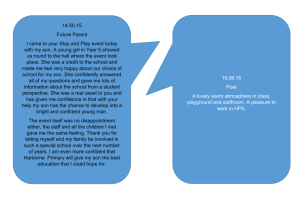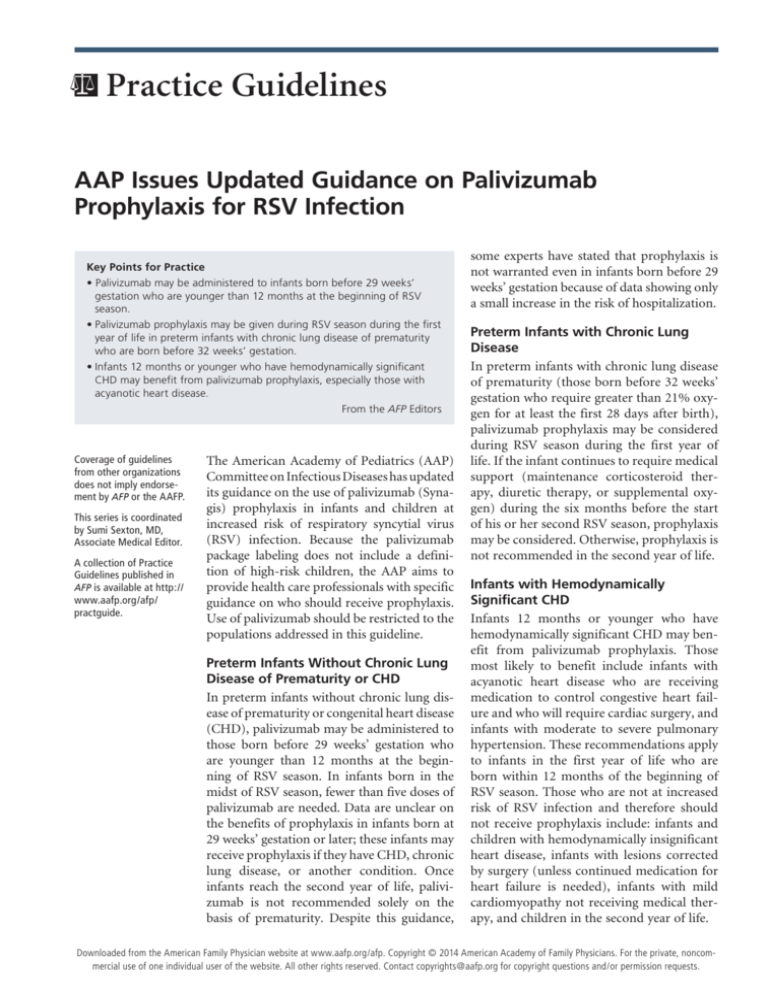
Practice Guidelines
AAP Issues Updated Guidance on Palivizumab
Prophylaxis for RSV Infection
Key Points for Practice
• Palivizumab may be administered to infants born before 29 weeks’
gestation who are younger than 12 months at the beginning of RSV
season.
•Palivizumab prophylaxis may be given during RSV season during the first
year of life in preterm infants with chronic lung disease of prematurity
who are born before 32 weeks’ gestation.
•Infants 12 months or younger who have hemodynamically significant
CHD may benefit from palivizumab prophylaxis, especially those with
acyanotic heart disease.
From the AFP Editors
Coverage of guidelines
from other organizations
does not imply endorsement by AFP or the AAFP.
This series is coordinated
by Sumi Sexton, MD,
Associate Medical Editor.
A collection of Practice
Guidelines published in
AFP is available at http://
www.aafp.org/afp/
practguide.
The American Academy of Pediatrics (AAP)
Committee on Infectious Diseases has updated
its guidance on the use of palivizumab (Synagis) prophylaxis in infants and children at
increased risk of respiratory syncytial virus
(RSV) infection. Because the palivizumab
package labeling does not include a definition of high-risk children, the AAP aims to
provide health care professionals with specific
guidance on who should receive prophylaxis.
Use of palivizumab should be restricted to the
populations addressed in this guideline.
Preterm Infants Without Chronic Lung
Disease of Prematurity or CHD
In preterm infants without chronic lung disease of prematurity or congenital heart disease
(CHD), palivizumab may be administered to
those born before 29 weeks’ gestation who
are younger than 12 months at the beginning of RSV season. In infants born in the
midst of RSV season, fewer than five doses of
palivizumab are needed. Data are unclear on
the benefits of prophylaxis in infants born at
29 weeks’ gestation or later; these infants may
receive prophylaxis if they have CHD, chronic
lung disease, or another condition. Once
infants reach the second year of life, palivizumab is not recommended solely on the
basis of prematurity. Despite this guidance,
some experts have stated that prophylaxis is
not warranted even in infants born before 29
weeks’ gestation because of data showing only
a small increase in the risk of hospitalization.
Preterm Infants with Chronic Lung
Disease
In preterm infants with chronic lung disease
of prematurity (those born before 32 weeks’
gestation who require greater than 21% oxygen for at least the first 28 days after birth),
palivizumab prophylaxis may be considered
during RSV season during the first year of
life. If the infant continues to require medical
support (maintenance corticosteroid therapy, diuretic therapy, or supplemental oxygen) during the six months before the start
of his or her second RSV season, prophylaxis
may be considered. Otherwise, prophylaxis is
not recommended in the second year of life.
Infants with Hemodynamically
Significant CHD
Infants 12 months or younger who have
hemodynamically significant CHD may benefit from palivizumab prophylaxis. Those
most likely to benefit include infants with
acyanotic heart disease who are receiving
medication to control congestive heart failure and who will require cardiac surgery, and
infants with moderate to severe pulmonary
hypertension. These recommendations apply
to infants in the first year of life who are
born within 12 months of the beginning of
RSV season. Those who are not at increased
risk of RSV infection and therefore should
not receive prophylaxis include: infants and
children with hemodynamically insignificant
heart disease, infants with lesions corrected
by surgery (unless continued medication for
heart failure is needed), infants with mild
cardiomyopathy not receiving medical therapy, and children in the second year of life.
◆ Volume 90, Number 12
December
2014
www.aafp.org/afp
American
Family
867
Downloaded15,
from
the American
Family Physician website at www.aafp.org/afp.
Copyright © 2014
American Academy of Family
Physicians.
For thePhysician
private, noncom-
mercial use of one individual user of the website. All other rights reserved. Contact copyrights@aafp.org for copyright questions and/or permission requests.
Practice Guidelines
Other Recommendations
Infants with neuromuscular disease or congenital anomaly
that impairs ability to clear secretions from the upper airway because of ineffective cough are at risk of prolonged
hospitalization from lower respiratory tract infection;
therefore, prophylaxis may be considered in the first year
of life. Prophylaxis may also be considered in children
younger than 24 months who are profoundly immunocompromised during RSV season. There are insufficient
data to recommend routine palivizumab prophylaxis in
children with Down syndrome or cystic fibrosis. In Alaska
Native and American Indian populations, infants may be
eligible for prophylaxis depending on the burden of RSV
disease.
Monthly prophylaxis should be discontinued in
infants who have a breakthrough RSV hospitalization.
The likelihood of a second RSV hospitalization in the
same season is extremely low.
Palivizumab prophylaxis is not recommended for
the prevention of health care–associated RSV disease.
Infants in a neonatal unit who qualify for prophylaxis
because of prematurity, chronic lung disease, or CHD
may receive a first dose of palivizumab 48 to 72 hours
before discharge or promptly following discharge.
Dosing
A maximum of five monthly doses of palivizumab
(15 mg per kg per dose) may be administered during the
RSV season to qualifying infants. Administering more
than this is not recommended within the continental
United States. Five monthly doses will provide more than
six months of serum palivizumab concentrations above
the desired level for most children. A dose beginning in
November and continuing for a total of five doses provides protection through April. Infants born during RSV
season may require fewer doses.
Guideline source: American Academy of Pediatrics
Evidence rating system used? No
Literature search described? No
Guideline developed by participants without relevant financial
ties to industry? No
Published source: Pediatrics, August 2014
Available at: http://pediatrics.aappublications.org/content/134/2/415.
full.html
MARA LAMBERT, AFP Senior Associate Editor ■
Code Confidently in ICD-10
Be properly compensated for the services you provide. Help your practice
through the ICD-10 transition with the AAFP Coding Toolkit.*
ICD-10 Educational Series
ICD-10 Flashcards
• Developed by coding experts, this 11-module voice-guided
PowerPoint series offers a comprehensive map to a
smooth ICD-10 conversion.
• Created to help physicians, practice managers,
coders, and those who work on office dictation easily
transition from ICD-9 to ICD-10.
Hip
ANGITI
MA
AS TH
IA
ns
s
ician
ly Phys
ician
s
of Fami
emy
Fam
ily Phys
Acad
Ame
rican
n Aca
dem
y of
rica
Ame
the
d by
Prod
8
uce
of Family Physicians
Physicians
Physicia
of Family
Physic
ians
my of
Academy
Family
n Academ
y of Family
Acade
by the American
America
can
Ameri
d by the
Produced
by the
Produce
ced
Produ
by the
12
uced
4
Prod
of Family Physicians
American Academy
of Family
Academy
American
by the
Toe
Produced
Produced by the
ITIS–L
YMPH
ANEM
s
Physician
IT
Knee
N DEFIC
OBESITY–WE
ATTENTIO
Ankle
Top 823 primary care Diagnoses
CELL UL
IGHT
S
ORDERS
564.09
Produced by the American Academy
ISBN 978-1-940373-04-1
564.02
INAL DIS
• Reach for this manageable
and easy-to-reference guide
time and time again.
AAFP
ICD-9 to ICD-10
Referential Flash Cards
564.01
SPRAINS–STRAINS
Educational
Series
ICD-10
ICD-10
ICD-9
Region ICD-9DESCRIPTION
K59.00 ICD-9
A60.04
DESCRIPTION
UNSPECIFIED
TION
LEFT
278.00 Obesity,K59.01
ICD-9RIGHT
ICD-9
DESCRIP
843.9 Unspecified
A63.0
sprains of unspecified
314.00
DESCRIPT
unspecifie
hip
ION
vulvovaginitis
Attentio S73.109– 681.0
S73.101– S73.102– ICD-9
d
054.11 Herpetic
nB37.3
Strain of muscle, Other
K59.02
deficit disorde 0
acuminatum)
DESCRI
fascia,obesity
and
tendon
314.01
the hip
due
S76.019–
PTION
warts (condyloma
ed
toof excess
278.01 Morbid
Attentio
rS76.011–
without S76.012–
493. DESCRIPTI ICD-10
078.11 Anogenital
caloriesA56.2
Strain of quadriceps
K59.09
tion, unspecifi
muscle,
(severe)
fascia,obesity
Cellul 00
and tendon n deficit
S76.119–
disorde S76.111– mention
Constipa
of vulva and vagina
ICD
of
itis andExtri ON
hyperac
due to excess
Attentio
r with hyperacS76.112–
-9
unspecified
112.1tion Candidiasis
Drug-induc
Strain
493.
nsic E66.9
tract,adductor
A53.9
muscle, fascia, and
tivity
constipa
n-deficit
absce
calories
tivity Acute10lymph
269
infection of genitourinaryof thigh
hyperac
tion
Use
ssasth
278.03 Morbid ed obesitytendon
Slow transit
ICD-10
ma,
Intrin
of
Chlamydial
Attentio S76.219–
constipa
tivity
S76.211–
finger
E66.09
099.55
493.
ion
angiti
unsp .9
A59.03 addit
sic
disorde S76.212–
n-deficit
ional
Drugsobesity
s of finger 280
ecifie Nut DESC
of(severe)
r, predom 90 Unsp asthm
681.10
hyperac
RIGH
Outlet dysfunct 097.9 Syphilis, Unspecified
code
Strain278.02
with
ofofmuscle,
Table
a, unsp
ritio
RIPT
F90.0
fascia, and tendon of Attentio
.0 d
the Overweigh
the alveolar
TIP
A60.9 tivity
tion
ecifie E66.01
Cellul
(B95inantly inattent
nal T ION
hypoventil
disorde
n-deficit
ecifie
Iron
280 d
itis and
posterior muscle group att thigh level
defi
LEFT
d asth
S76.319–
r, predom
hyperac ation
ive
S76.311–
Other constipa 131.02 Trichomonal urethritis effects column
S76.312–-B97Mild
type
Other obesity R19.7 Attentio
.8
defi L03.011cien
) tointer
TIP
E66.1
Acute
ma,
UNSP
iden
cien
cy,L03.0
disorde abscessinantly hyperac
n-deficit N34.1
682.3 tivity
(endocrine
unco
Othe
L03.0
the adverse
StrainV77.8
mitte
unspecified
of otherScreening
799.51
tifyntinfec 281
EC
uns 12
specified muscles,
seeherpes,
hyperac Cellul lymphr,angiti
, endogenou
combin ofMild
tive
fascia,
toe
Genital
and
r F90.0 cy21ane
DES
type
Attentio
054.10ation,
K52.9
tivity disorde
asthtious.0 mplic
s)
ated spe
unspecified
type persistent E66.2
s ofedtoe
itis of S76.812–
miaL03.0pecifiedL03.0 CRI
tendons
S76.819–
cifie
n and concen
constip
Pern
ma, agen
266
level for obesity
S76.811–
783.1at thigh
19 PTIO
axilla
seco 22
r,
duced 099.40 Other nongonococcal urethritis,
Mod
Acute
other
Abnormal
iciouF90.1 d iron
E66.3 .2 unco
asthm
tration lymph
t when
N
erate
TIP
nda L03.029
mplic
weight
843.0 Iliofemoral
For drug-in als.
s repo
deficit angiti type
defi
gainA09ess of a condition
a, unco Defi
281
sprain
783.21 ligament
of hip
pers E66.8
ICD-1
Codes
S73.119– CutanS73.111–
.9 mplic cienated ane
Seve
Loss
miarting ciency ry to bloo
isten
0
s
within
eous 493.S73.112–
and Chemic
weight
andofnonresponsiven
843.1 Ischiocapsular
when
K59.1 resistance
(Vit code ane
t asth
Uns ated cyF90.2
resistance
(ligament)
L03.0
absce 02of axilla re persisten 282
of
d loss
783.22 Underweig
sprain
of drug
CellulS73.121–
hip categories
ami s L00-mia
S73.129–
identify
Diarrhea
.5 ma, uncopecified othe
31
ss
itis of 493.TIP
does not
code for any associated
n B12
S73.122–
axillaExtrinsic
F90 throug
code
(chr
787.91
t Z13.89
s
843.8
ht
F90.8 r spe L03.0
Other sprain
asth
L08.
K52.2
Use additional
L03.0
upper
of hip
282 ma, Sick
the infection
if
Acute
12
diarrhea
onic
defi 41
asth
(Z16.–)
cifie 32 due
h F98 limb
S73.199–
.61 unco le mplicated
drugs
Chronic
S73.191–
Intrin
lymph
R63.5
)
ma with
S73.192–
to intri
dB
L03.0
493.may
to antimicrobial
844.9
B99.9.
558.9
R41.840
Unspecified
L03.1ciency L03.0
sic asth
angiti
be used
282 (acu Sickmpliccell trait
Cutan
39
92
Code firstsprain of knee
s diarrhea
A00.0 through
11
ane 42grouL03.0
682.4
s of upper
S83.90X– eous
J45.
.62 te) le cellated
regard
S83.91X–
p vita nsic fact
R63.4
Unsp
Infectiou reporting codes
ma less
obesity complica
mia
909
vaginitis.
ICD
absce S83.92X–
L03.1
L03.1
517.
with
Sprain
TIP Cutan
exac
of unspecified
009.2
ecifie
(O99.2149
collateral ligament
limbd
min
Vaginitis-Vulvo
of
-10
12(nut
ss
3 the Sick
andatcolitis
knee 682.6
(acu
erba disease 21
al diarrhea
ting of
codes
S83.409– eous
) when reporting
J45.
s (fola or deficien
ageleof
pregnanc
teritis
asth 282 R63.6
ritio
upper
Mild
S83.402–
te) exac
tion
Function See additional
cella patien
absce of
L02.4 with L03.1
20
N30.00 S83.401–
844.1 Sprain
Cellul
E63
gastroen
y,
ma
nal)
of
medial
childbirth
inter
Use
limb
564.5
collateral
).
22
codes
TIP
11
ss
cris
te, Vita
.62
additiona
.9
knee
erba L03.1
ofS83.412–
S83.419– itis of
mitte 289 with
from category
and
and dietetic
-Z91.02l code ligament ofK52.89
is t. outL02.4
J45. cy)
hand
the puerperi
lower
Mild
Acute
cris 12
595.0 Acute cystitis
Allergic
N30.01 S83.411–
nt asth.52 (acu
Sick
844.0
min 30
(Z91.01
or
D50
(inclu
Sprain
sixth
of characte
13
te)leexac tion with
E66.
lateral collateralfor
adverse
limb
pers
is
hematuria
um, des
ligament
558.3
lymph
.0
without
if applicab
effect,
S83.429–
A08.4 if applicab
cell erbaL03.1 acuteL03.1
food allergy
S83.421–
J45. B12)
282 male,
r 5) when of knee
finger
Acute cystitis
angiti
S83.422–isten
Cutan
Mod
t asth
che 14
844.2 Use
type of
D50
cris tion 23
40
Sprainadditiona
.62
s) with (acu
reporting 682.7
of unspecified cruciate
s lower
eous
erate
le, toabsce
is with
with hematuria
.8
identifyofdrug
code E66.1.
to identify
S83.509–
te) exacL02.4
other specified
l code to ligament of knee
L03.1st syndrom
persi 284 ma withSick
S83.501–
CutanN30.10
Acute cystitiscolitis,
J45.
S83.502–
category
limb
Seve
al code
24
13
identify
ss
844.8
682.0
(T36-T50
D51
stent .19
50
eous 493. of lowerre
(acu
le cell
E66. ligament of knee body mass S83.519–
erba splenicL02.4
cystitis Sprain of anterior
teritis and
.0
with
e
absce
asthm Othe te)
pers
01
Use addition tive595.1
Cellul N30.11
S83.511–
gastroenChronic interstitial 844.2 V85.21 hematuria
cris L02.5tion
limb
K58.0 index
isten 285.1 fifth
seq 14
11
ss ofExtriS83.512–
a withr pan exac
itis 493.
(BMI),
E53
Sprain ofBMI
erba
is,
posterior
e specified (chronic) without
cruciate ligament of knee
t
Noninfec
footnsic
if known
25.0-25.9,
L02.5uestrati
uns
.8
tion
Acute of face
(acut
S83.529–
(inclu
11
558.9
(Z68.-)
cyto L03.1
asth
Interstitial cystitis 844.3 V85.22hematuria
285asthma Acu
adult
not otherwis
15
S83.522–
pec
12
K58.9
des
lymph493.S83.521–
when
on
Intrin
D53
withte pos e) pen
matoes)
Sprain
.21
with ofBMI
ified L03.1
superior
L02.5
tibiofibular joint and ligament
reporting
L03.1
Viral enteritis,
with
26.0-26.9,
angiti
sic asth 285
Cutan
(acu them exac
.9
e
iaerba
cystitis (chronic)
S83.60X–
19
91
25
S83.61X–
16
Interstitial
Ane
682.1
adult
008.8
s
statu
S83.62X–
te)
syndrom
eous
J45.
TIP
844.8 V85.23
K57.30Cellul
ma with
D57
exacL02.4 tion L03.1
face
Sprain ofBMI
bowel
.22
mia
other
s asth
absce ofAsth
901
specified parts of knee reporting
codes from
27.0-27.9,
.3
Irritable
S83.8X9–
e with diarrhea
in chro orrherba
26
ss of ma,
agic15
mati
S83.8X1–
itis of
when
adult
unsp 285.29 statuAne
564.1
J45.
(B95-B97)
845.09 V85.24
face S83.8X2–
bleeding
cus L02.6 tion
Strain
Mild
D57
K57.32
ane L02.4
mia
neck
agent
ofBMI
Achilles
s asth
ecifie
, ortendon
bowel syndrom
diarrhea
Acute
21
infectious
28.0-28.9,
.1
16
S86.019–
Irritable
in neo nic kidn 11 mia
d typeAneZ68.25
e without to identify
mati
S86.011–interS86.012–
lymph N34.1
on, abscess
adult
mitte
V85.25
(acu
J45.
syndrom code
cusplas
ey dise L02.6
perforati
Strain ofBMI
, with
angiti Mild
mia
Cutan
Use
muscle(s)
K57.10
nt asth
and tendon(s) of anterior
or bleeding
boweladditional
31
Z68.26
,
te
without
D57
29.0-29.9,
12
682.2
s
persi
eous
of
tic
statu
of
blooL02.6
Irritable category N30.
ase
.01
adult
neck stentCode ma with
intestine
othe
on, abscess
dise
V85.30
muscle
absceN34.2
group at lower
J45.
d loss19
CellulS86.219–
leg level
Mod
BMI
r chro
K57.12
ase
Z68.27 s asth
asthmfirs
ssS86.211–
41
, or bleeding
losis of large
30.0-30.9,
itis of
erate S86.212–
without perforati on,
unspecified
L03.2 )
abscess
Diverticu597.80 Urethritis,
t neo status asth mati
adult
niccus
trunk of neck
Strain of other
V85.31
intestine
persCode a with
J45.
muscle(s)
11
D57
and tendon(s) at Cutan
562.10
dise
Seve
perforati
BMI 31.0-31.9,
Z68.28
statu
eous493. N34.3
K57.50
pla
51
mati
or bleeding
litis of large urethritiswithout
(eg, postmenopausal)
.02
L03.2
ase
re pers Coistent firs
absce
lower on,
sm
cus
S86.819–
leg abscess
level , adult
Diverticu597.89 Other intestine
81 ssN39.0
und s asthm
S86.811–
V85.32
12
or bleeding Cellulitis
de astht ma
S86.812–
isten
562.11
Exer
Z68.29 (C0
of abdom
aticu
perforatiBMI 32.0-32.9, n, abscess,
erly
unspecified
K57.52of
with
D57
493.
L02.0
losis of small syndrome,
t first
0-D
cise syphilis
845.00
abdom
without
s
Strain of unspecified
ing
perforatio adult
.00
statu
und
Diverticu597.81 Urethral
muscle and tendon
V85.33
1
inal wall asthma
induc
bleedingatAcute lymph 82 inal
49)
intestine
specified
without
not
BMI
s asth
Z68.30 chr
site
562.00
witherly
L03.2
33.0-33.9, n, abscess, or
ed bron(A52.7
wall
D61
infection,
lower
intestine
leg level
angiti Coug
litis of small tract
onimati when
Cutan S86.919–
h varia 285
statu
S86.911–
largeV85.34
21
ing
TIP
.818
S86.912–
s ofN39.0.
perforatio
Diverticu599.0 Urinary
TIPadult
chos 9),Z68.31
eous code
J45.
cus
small and845.00
nt .3 Ant
BMI
astheas c kid
abdom 285
without
562.01
absce Othe
pasm ands dis
902
Sprain
Cellul
ney reporti L03.222
of 34.0-34.9,
mati
reporting
unspecifiedadult
D62
intestine
r asth inal asth
losis of both
ligaments of ankle
when
ss of S93.401–
largeV85.35
itis ofS93.409–
.9 ma ineoplas
ngL02.1
dis
Diverticu
tub e,cus
J45.
agent (B95-B97)
back ma wall
BMI
small and845.02
Z68.32
back
cod1
35.0-35.9,
infectious
Acute ICD
Ane
22
Calcaneofibular
D63
(exce S93.402–
lower
identify
tic che erculo such as: ease
N40.0
ligament
and other
litis of both
adult
code toV85.36
lymph
pt S93.412–mia,
-10.1
S93.419–
L03.3 e D6
Diverticu
Use additional
BMI 36.0-36.9,
without urinary obstruction Cutan Use angitisCM S93.411– butto
unsZ68.33 mothera sis (A18 hyp (CK
845.01 Deltoid
3.0 J45.32
ck)
D) 19
D63
of prostate
pec
Cate
eous S93.429–
V85.37 BMI ligament adult
.0
L02.2 (N1
Hypertrophy (benign)
ified
add of backS93.421–
absce
py indu .89 othyro
gory
S93.422–
Cellul smo
Z68.34
(LUTS)
37.0-37.9,
N40.1
ssition
Tibiofibular
) wh idis 11 8.-) wh J45.42
D63
symptoms
itis lowerkeurinary
ligament
600.00 urinary tract845.03
and other
J45
of chest
adult
al cod
ced
V85.38 BMI
.8
S93.439–
enL03.311m (E0
chest
en
(Z77
inclu
with urinary obstruction Acute ofoftoba
S93.432–
J45.
ane
wall
Z68.35
of prostate
rep
845.09 Other
38.0-38.9,
rep
e,
wall .22) S93.431–
ankle
des
lymph cco
ligaments
52
mia L03.3
(internal collateralCutan
TIP
orti 0.0
adult
Hypertrophy (benign)
ligament)
R97.2where
V85.39 BMI
(Z57angiti
S93.499– , S93.491–
both
exp
-E0 orting
21 ng
Z68.36
app
osu S93.492–
39.0-39.9, of great toe
eous .31), s of use
600.01 tract symptoms (LUTS)
intri
Unspecified
cod J45.3.9
cod
990
L02.2
licab
adult
nsic
tobachest(Z87
N45.4re to
Cellul fromabsce
V85.41 BMI antigensprain
(PSA)
S93.503–
e D6 ), sym
e D6
12
.89
S93.501–
le,Z68.37
ss of cco wall
S93.502–
toba
and
itis of cate
J45.
40.0-44.9,
1),
prostate-specific
to
Unspecified
L03.3
groin
3.8
sprain
abscess
gory
3.1
cco
of lesser
dep
991
pto
extr
occ
iden
groinS93.506–
toe(s)Acute
s, with
adult
790.93 Elevated V85.42 and epididymo-orchiti
12
end S93.505–
insic
upa
smo
ma
J45 S93.504–
lymph
J45.
enc
tion Z68.38 tify:
tic
epididymitis,BMI 45.0-49.9,
asth L03.322
sprain of unspecifiedCutan
998
toe eous angitiS93.509–
late
604.0 Orchitis, V85.43 Unspecified
N45.1 e (F17 al expke in the exposu
ma
s
unspecifiedadult
BMI 50-59.9,
.-), andZ68.39
L02.2
osu
epididymitis,
peri re to
845.13
and
Sprain
absce of groin
of interphalangeal
joint ofCellul
re
envi
adult
nata
13
great
604.90 Orchitis V85.44
N45.2
itistoe
S93.511–
of perine
toba to envi
ronm
l peri L03.3
S93.512– Z68.41
D64
of perine ssS93.513–
BMI 60.0-69.9,
Sprain
cco
of interphalangeal
Epididymitis
.81
joint Acute
of lesser
N45.3
adult
toe
umS93.516– um S93.514–
use ronmentaodL03.3
V85.45 BMI
(P9613ental toba
lymph
S93.515– Z68.42
D64
(Z72
angiti
Cutan
70oformetatarso-phalangeal
Orchitis 845.12 Sprain
toba 23.81), histo cco
greater, adult
.9
joint eous
of great toe s ofS93.523–
.0) whel L02.2
N48.1
V85.53 s
perine
S93.521–
cco
S93.522– Z68.43
absce
Cellul
14 smo ry
Sprain
um
pediatric,
of metatarso-phalangeal
n repo
ss
Epididymo-orchitiBMI
itis of
joint
85th 682.5
ke
of lesser
L03.3
V85.54 toe(s)
percentile
umbil of umbilicus
Cellul
BMI pediatric,
14 rting cod
to less
S93.524– S93.525– Z68.44
itis ofthan 95thicus S93.526–
607.1 Balanitis
L03.3
greater thanTIP
butto percentilereporting
es
Acute
24
or
ck when for age codes 20
Z68.45
equal
lymph
to 95thagent
L02.2
infectious
angitipercentile for
Cutan
Note: BMI
15
to identify the
age
s
Z68.53
eous
22
adult
code (B95-B97)
L03.3
continued
Produ
absce
TIP of buttock
Produce
Produced
Use additional
Producecodes areced
15
ssProd
forbyuse Prod
byor
dd by
of butto
Z68.54
theN48.1.
by the
L03.3
American
the for
the America
persons
by N45
category
22uced
the American
uce ck
fromProduced
Ameri
Academy
Physicians
continued
s 20Physicians
by the21 years
Academy
ofAmerica
25
Family
Family
of
d by
nn Academ
Physician of Family
Academ can48Acade
oftheage or
Ame
American Academy
L02.2
Physicians
yy of
of Family
48
of Family
Produced by the
Family32my rican
16
Ame older.
Academy
of Family
Physicia
Physicia
Acad
rica
L03.3
American
ns
ns
emy
the
n Aca
by
Physic
16
10 of
Produced
Fami dem
ians
L03.3
ly
17
12 Physy of
32
icianFam
L03.3
s ily
27
8Phys
L02.3
ician
10
10 1
s
ICD-9
564.00
GENITO–URINARY
• Put the 823 top primary care
diagnoses at your fingertips.
L INTEST
• Gain in-depth knowledge of
ICD-10 guidelines and learn
how they differ from ICD-9.
ICD-10
FUNCTIONA
• Access the top 50 diagnosis
codes for family physicians.
ISBN 978-1-940373-01-0
Start mastering ICD-10 today
aafp.org/coding-toolkit
868 American Family Physician
Series
ICD-10 Flashcards
sold separately.)
www.aafp.org/afp *(ICD-10 Educational
Volume
90,and
Number
12 ◆ December
15, 2014
4




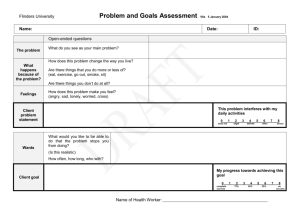
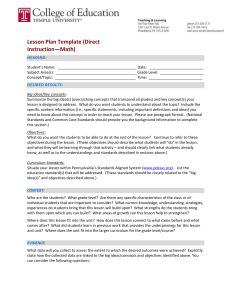
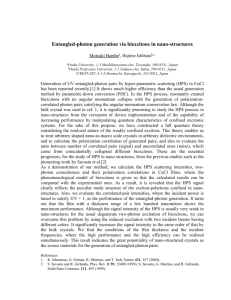
![Lesson Plan Template: Teacher Facilitated Literacy [doc]](http://s3.studylib.net/store/data/006681424_1-f242ece395a51b1c33fbc141f61f3ce4-300x300.png)
